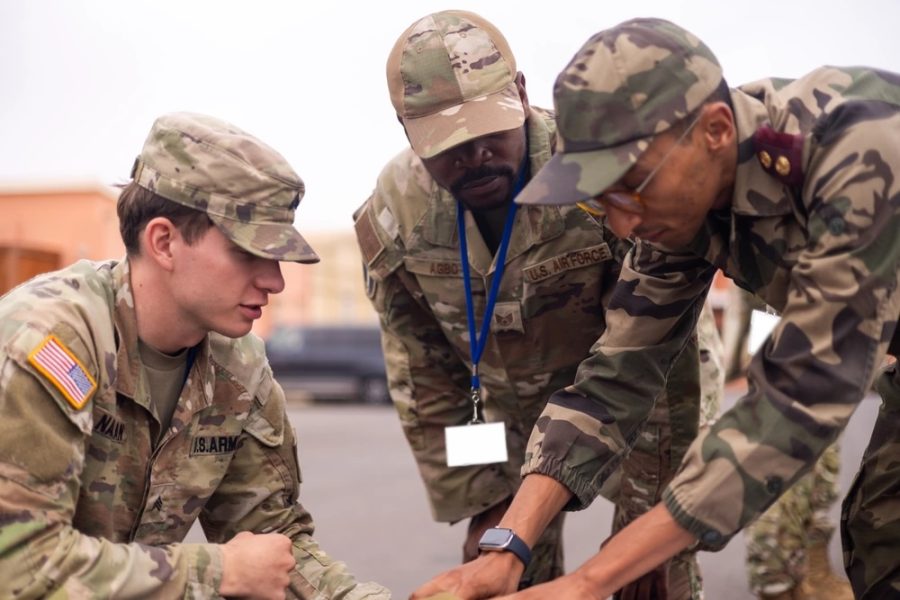As the Air Force prepares the first six versions of its Air Task Forces, the head of the Air Force Culture and Language Center is pitching an idea that he believes will help ATFs be ready to generate sorties as soon as they deploy: a dedicated expert to help each ATF learn how to work with its host nation long before they arrive there.
“No one is better than our Air Force at generating sorties and prosecuting targets,” said AFCLC head and retired Air Force Col. Walter Ward. “But there’s vulnerabilities and host nation dependencies when it comes to operating a base, which is our core power projection platform.”
Those vulnerabilities and dependencies include infrastructure, utilities, logistics, security, local acquisition, air traffic control, and other factors which may vary wildly between deployment locations and “can easily degrade sortie production and tempo” if interrupted, Ward pointed out.
But if an Air Task Force can sort out those details and begin integrating with the host nation beforehand, it can hit the ground running when it’s finally time to deploy.
“The ATF construct provides an opportunity to build partnerships and address those types of things before deployments, so when it’s time to go, you’re at 100 percent,” Ward said. “You put the learning curve behind you.”
The Air Task Force is a new deployment model that the Air Force believes is a more efficient and effective way of going to war. Each ATF is commanded by an A-Staff, made up of department heads who oversee personnel, intelligence, operations, logistics, and other areas.
Under them falls the combat air base squadron, which covers base protection, engineering, airfield management, and other support functions. The pointy end of the ATF is handled by the mission generation force elements, which may consist of a fighter squadron or special warfare squadron, for example. Maintaining the MGFE aircraft falls to the ATF’s mission sustainment teams.
In May, the Air Force announced the first six locations where ATFs will be headquartered:
- Davis-Monthan Air Force Base, Ariz.
- Scott Air Force Base, Ill.
- Joint Base San Antonio, Texas
- Dyess Air Force Base, Texas
- Fairchild Air Force Base, Wash.
- Seymour-Johnson Air Force Base, N.C.
The ATF pairs with an overhaul of the Air Force’s deployment schedule, where units train, deploy, and return home together under a new concept called Air Force Force Generation. AFFORGEN creates a 24-month cycle broken into four six-month segments: prepare, certify, available (meaning available to deploy), and reset.
Ward thinks the prepare stage could be the perfect time for a dedicated A-staff position to begin helping the unit integrate with its host nation-to-be. AFCLC has a long history of achieving such integration through its Language Enabled Airman Program (LEAP), where Airmen and Guardians with significant experience in a foreign language serve as cultural and linguistic experts for their fellow service members.
LEAP scholars bridge the culture and language gap between American troops and their foreign counterparts, and they also translate military jargon so the two camps can work more closely together. Many LEAP scholars work in the maintenance, aviation, intelligence, or whatever career field they are translating about, which gives them an edge over civilian or non-specialized translators.
“I will never do another bilateral exercise without requesting the language and cultural expertise that LEAP was able to provide,” U.S. Marine Corps Col. Thomas Siverts said in a press release after an exercise with Philippine Marines in 2022.
The Air Force should use that expertise to get ATFs and their host nations on the same page early, Ward suggested. It could be particularly useful under Agile Combat Employment, an Air Force strategy where small groups of Airmen launch sorties from smaller, more spread-out locations to avoid being targeted by enemy missiles. As a result, they may have to operate out of unfamiliar airfields run by unfamiliar partners.
“There’s an opportunity in that prepare phase to bring in LEAP talent on the Air Staff to really start to build that partner integration, particularly when it comes to operating the base, on all the things that we would have to learn on the fly otherwise,” he said.
Beyond LEAP scholars, ATFs could also consult AFCLC’s academic faculty or its free mobile app, which offers culture briefings for more than 80 countries. That kind of background knowledge can help with the non-technical aspects of integration: for example, what an American might consider acceptable forms of humor, gift-giving, and etiquette may not work in a host nation’s culture.
“There are many different languages and cultures that are not ‘plug and play,’” Ward said. “We have to know the languages, we have to understand where the flashpoints between cultures of our partners and allies are, in order to multiply the number of credible teams that can operate at a greater speed and without loss of capability.”
That understanding is not just a nice-to-have, the director said, it’s a key part of the U.S. National Defense Strategy, which calls on integrating with partners and allies as a means to deter rivals such as Russia and China from the Arctic to the western Pacific, while still fighting extremism in the Middle East.
“The only way that math works is through highly-effective partner integration,” Ward said.
In October 2025, two of the six ATFs will deploy to the Middle East, while a third will deploy to the Pacific. The other three ATFs will replace the first batch in April 2026. Ward said the response has been favorable in the two ATFs his team has briefed so far, with another one scheduled in September.
“The message on incorporating LEAP scholars into the A-Staffs and using AFCLC content to enhance readiness, mitigate risk in coalition operations, and increase operating tempo has been very well received and more importantly, being put into action,” he said. “It’s resonating loud and clear to our tip-of-the-spear commanders that culture plus language equals speed.”
